How to Fire an Employee: A Comprehensive Guide for Call Centers and BPOs
In this article, you will learn about How to Fire an Employee: Learn effective, legal, and compassionate methods for terminating employees, ensuring minimal disruption in your call center or BPO.
5 min read
How to fire an employee is one of the most challenging tasks for any manager, especially in call centers and BPOs where staff turnover can be quite high. Firing an employee not only affects the individual but also the entire team, leading to potential disruptions in productivity and morale.
In this comprehensive guide, we will walk you through the crucial steps of terminating an employee while ensuring legal compliance, maintaining dignity, and minimizing negative impacts on your business.
For call centers and BPOs, efficient management of workforce dynamics is crucial. These organizations often face high-pressure environments where metrics like customer satisfaction, average handling time, and resolution rates are key performance indicators. Underperformance or behavioral issues can significantly impact these metrics and ultimately the business’s bottom line. Therefore, learning how to effectively and compassionately fire an employee is of paramount importance.
In recent research by SHRM, it was found that the average cost of a bad hire is nearly $15,000. Additionally, a Gallup study reported that disengaged employees cost U.S. companies up to $550 billion annually in lost productivity. These statistics underline the importance of making informed and strategic decisions when it comes to employee terminations.
This guide will provide you with actionable steps, pro tips, and best practices to navigate the complex process of firing an employee effectively and ethically. Whether you’re a CXO, HR manager, or operations manager, this guide will serve as a valuable resource to ensure your termination process is handled with care and professionalism.
Keep reading to discover the essential strategies and tips on how to fire an employee the right way.
Understanding the Reasons for Termination
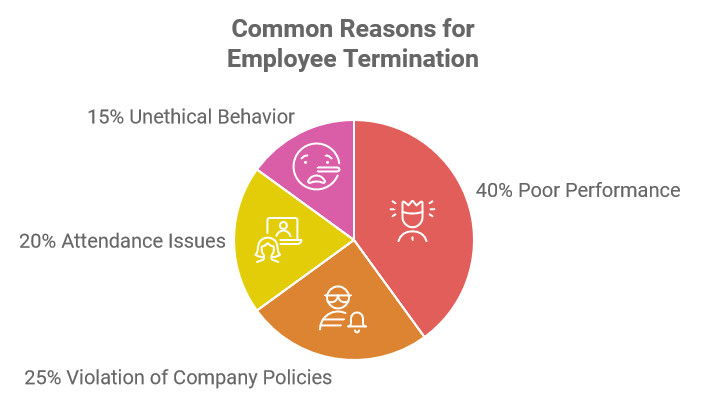
Before you fire an employee, it’s crucial to understand and clearly document the reasons for their termination. This step is vital not only for legal compliance but also for maintaining a fair and transparent work environment. Common reasons for termination include poor performance, violation of company policies, attendance issues, and unethical behavior.
When it comes to poor performance, consider whether the employee was given enough training, resources, and support to meet their job expectations. Poor performance might be due to a lack of clear instructions or insufficient performance metrics. Evaluate if coaching, additional training, or a Performance Improvement Plan (PIP) might rectify the situation before opting for termination.
Violations of company policies can range from minor infractions like punctuality issues to major concerns like harassment or fraud. It’s crucial to have a well-documented employee handbook that outlines all company policies and the consequences of violating them. This ensures that the employee is aware of the expectations and repercussions.
Attendance issues are another common reason for employee termination. Chronic lateness or frequent unapproved absences can disrupt team cohesion and productivity. Ensure that your attendance policies are clearly communicated to all employees and enforced consistently.
Unethical behavior, such as theft, harassment, or insider trading, should be addressed immediately. In such cases, termination might be the only viable option to maintain a safe and ethical work environment.
Pro Tip
Always conduct a thorough investigation to understand the underlying reasons for the employee's behavior or performance issues. This will provide you with a clear and justified reason for termination.
Legal Considerations When Firing An Employee
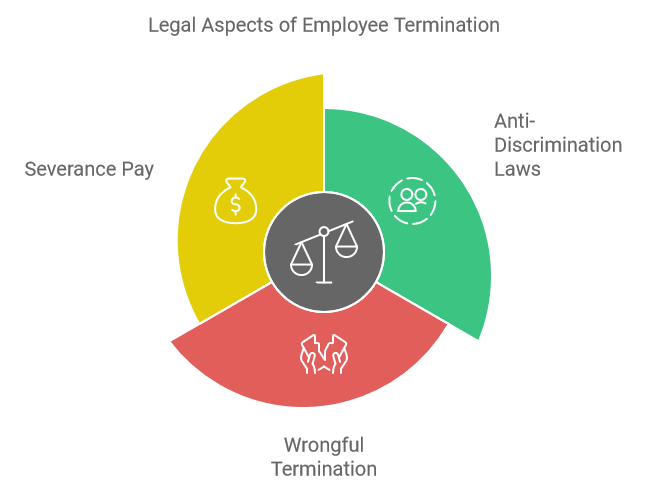
Terminating an employee comes with numerous legal implications. Failing to follow legal guidelines can result in lawsuits, fines, and damage to your company’s reputation. It is crucial to comply with federal, state, and local laws when terminating an employee. Some of the key legal considerations include anti-discrimination laws, wrongful termination, and severance pay.
Anti-discrimination laws prohibit terminating an employee based on race, color, religion, sex, national origin, age, disability, or genetic information. Ensure that your termination decision is solely based on performance or behavioral issues and not discriminatory in any nature.
Wrongful termination occurs when an employee is fired in violation of an employment contract or legal regulations. It’s essential to review any contractual obligations and company policies before proceeding with the termination. If you operate in an “at-will” employment state, you have more flexibility; however, be mindful that this doesn’t exempt you from potential wrongful termination claims.
Severance pay might be required depending on your company’s policies or the employee’s contract. Transparency and consistency in offering severance packages can help in mitigating potential conflicts and ensuring a smoother transition for the affected employee.
Pro Tip
Consult with legal counsel or an HR specialist to ensure that you are fully compliant with all legal requirements for employee termination in your jurisdiction.
Preparation for the Termination Meeting With The Employee
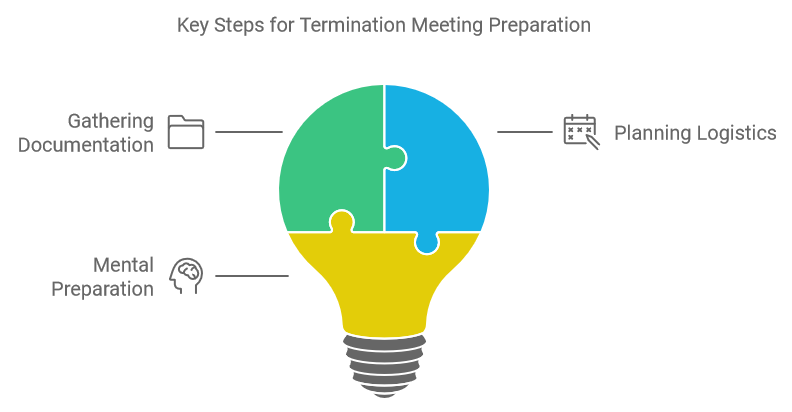
Proper preparation is crucial for a smooth termination process. This includes gathering all necessary documentation, planning the logistics, and mentally preparing yourself for the conversation.
Start by compiling all relevant documentation, such as performance reviews, warning letters, and attendance records. This will help you present a clear and factual case during the termination meeting.
Choose an appropriate location for the meeting. Ideally, this should be a private setting where you can speak confidentially without interruptions. Avoid public places or open office spaces.
Mental preparation is equally important. Plan what you are going to say and anticipate potential reactions from the employee. Practice delivering your message in a calm, respectful, and empathetic manner.
Pro Tip
Have a witness, such as an HR representative, present during the termination meeting to ensure transparency and provide support if needed.
Conducting the Termination Meeting With The Employee

The termination meeting is the most critical part of the process. How you conduct this meeting can significantly impact the employee’s reaction and the overall outcome.
Start the meeting by clearly stating the purpose. Be direct yet compassionate. For instance, you could say, “I called this meeting to discuss your employment with the company and the decision that has been made regarding it.”
Present the facts and reasons for the termination. Use the documentation you gathered to support your points and ensure that your explanation is concise and objective.
Allow the employee to express their thoughts and feelings. While the decision might not change, providing them with an opportunity to voice their side can help mitigate any negative emotions and demonstrate respect for their perspective.
Discuss the next steps, including any severance packages, return of company property, and the final paycheck. Ensure that the employee understands what to expect in the coming days.
Pro Tip
Provide a written termination letter during the meeting that outlines the reasons for termination, final compensation details, and any other essential information.
Communicating with the Team

After the termination meeting, it is essential to communicate the decision to the rest of your team. This helps maintain transparency and prevents the spread of rumors.
Inform your team about the termination decision as soon as possible, ideally on the same day. Keep the communication brief and factual. Avoid sharing specific details or reasons for the termination to protect the privacy of the affected employee.
Reaffirm the team’s goals and reassure them that the decision was made in the best interest of the company and the team. Highlight the importance of continuing to work collaboratively and maintaining high performance standards.
Encourage your team to come to you or HR with any questions or concerns they might have regarding the termination or their roles.
Pro Tip
Schedule a follow-up meeting with the team to address any lingering concerns and reinforce a positive work environment.
Providing Support to the Affected Employee
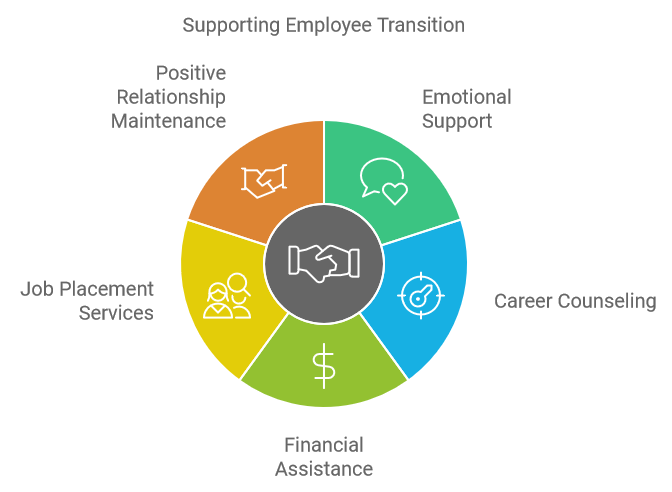
Even though the employee is being terminated, offering support can help ease their transition and maintain a positive relationship.
Consider providing outplacement services, such as career counseling, resume writing assistance, and job search resources. These services can help the employee find new opportunities and move forward with their career.
If appropriate, write a referral letter highlighting the employee’s strengths and contributions during their time with the company. A positive reference can significantly impact their job search prospects.
Ensure that the employee has access to any necessary mental health resources. Termination can be emotionally challenging, and providing access to counseling or support groups can be beneficial.
Pro Tip
Send a follow-up email or letter a few days after the termination to offer additional support and reiterate the resources available to them.
Reviewing and Improving the Employee Firing Process
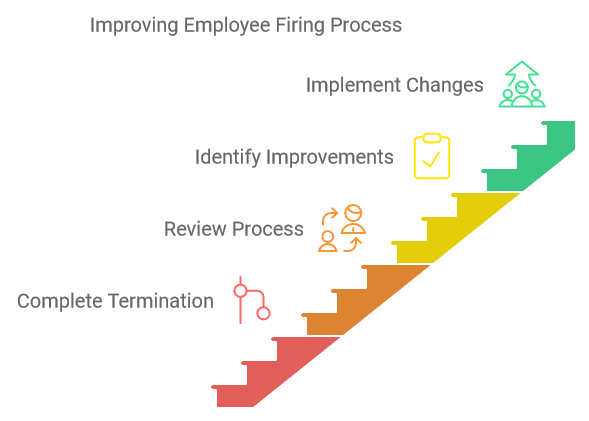
After the termination is complete, it’s important to review the entire process to identify areas for improvement.
Conduct a post-termination debrief with the HR team and any other relevant stakeholders. Evaluate what went well and what could have been handled better. Use this feedback to refine your termination procedures and policies.
Analyze the documentation and evidence used during the termination process. Ensure that all records are accurate and securely stored for future reference.
Consider conducting exit interviews with other employees to gather insights on how the termination was perceived and its impact on team morale. This feedback can guide future decisions and improve overall management practices.
Pro Tip
Regularly update your employee handbook and training programs to reflect any changes or improvements in the termination process.
In conclusion, knowing how to fire an employee effectively and compassionately is essential for maintaining a healthy and productive work environment. By understanding the reasons for termination, complying with legal requirements, preparing thoroughly, and conducting the process with empathy, you can minimize the negative impact on both the employee and your organization.



